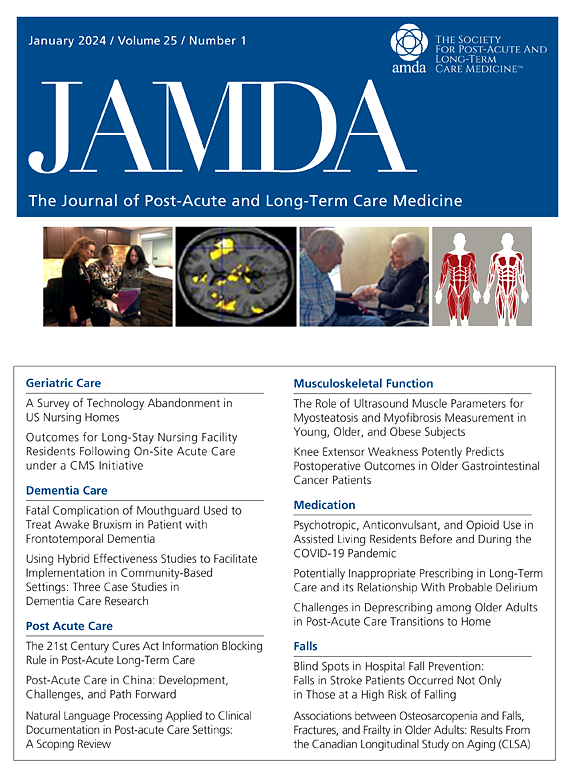新型阿片类药物评估工具在熟练护理机构康复患者中的可行性。
IF 4.2
2区 医学
Q2 GERIATRICS & GERONTOLOGY
Journal of the American Medical Directors Association
Pub Date : 2025-05-30
DOI:10.1016/j.jamda.2025.105679
引用次数: 0
摘要
目的:阿片类药物治疗的统一标准化评估不存在,以指导管理决策的患者在熟练护理设施(snf)。本研究的目的是确定(1)一种新的阿片类药物评估工具是否可以可行地用于支持临床医生对康复患者阿片类药物管理的决策,以及(2)该工具是否可以解决snf疼痛管理护理方面的现有差距。设计:本定性研究从主题上分析了SNF提供者的匿名访谈反应。环境和参与者:1个医院系统的SNF提供者和SNF护理人员参加了结构化访谈。方法:疼痛评估和记录工具,经过验证,以评估阿片类药物治疗及其对门诊环境功能的影响,被修改为评估snf中的阿片类药物治疗。SNF提供者被邀请参加关于该工具的使用和可行性的匿名访谈。访谈记录使用NVivo数据分析软件进行分析,以生成主题,以确定最重要的结论。结果:对20名医疗服务提供者进行了访谈,发现该工具可用于snf,以改善临床决策。评估患者的日常生活活动和阿片类药物滥用风险是该工具最积极考虑的指标。该工具为管理决策提供了标准化和特异性,解决了目前在标准化和提供者之间沟通方面的差距,并改善了物质使用障碍和认知障碍患者治疗中的现有可变性。实施的障碍包括该工具过于冗余,可能导致工作人员负担加重。结论和意义:本研究发现,这种新的阿片类药物管理工具在snf中是可行的,它规范了阿片类药物管理,改善了提供者的沟通,减少了治疗物质使用障碍患者的可变性。本文章由计算机程序翻译,如有差异,请以英文原文为准。
Feasibility of Novel Opioid Assessment Tool for Rehabilitation Patients in a Skilled Nursing Facility
Objectives
A uniform standardized assessment of opioid treatment does not exist to guide management decisions for patients in skilled nursing facilities (SNFs). The purpose of this study is to determine if (1) a novel opioid assessment tool can be feasibly used to support clinician decision-making in opioid management for patients in rehabilitation, and (2) if this tool can address the existing gaps in care to pain management in SNFs.
Design
This qualitative study thematically analyzed anonymous interview responses from SNF providers.
Setting and Participants
SNF providers and nursing staff from SNFs in 1 hospital system participated in structured interviews.
Methods
The Pain Assessment and Documentation Tool, validated to evaluate opioid therapy and its impact on function over time in the outpatient setting, was modified to assess opioid treatment in SNFs. SNF providers were invited to participate in anonymous interviews regarding the tool's use and feasibility. Interview transcripts were analyzed using NVivo data analysis software to generate themes to determine the most significant takeaways.
Results
Twenty providers were interviewed and found that the tool was feasible for use in SNFs to improve clinical decision-making. Assessing patient's activities of daily living and opioid misuse risk were the most positively regarded metrics of the tool. The tool was found to provide standardization and specificity for management decisions, address the current gap in standardization and communication between providers, and improve existing variability in treatment of patients with substance use disorder and cognitive impairment. The barriers to implementation include that the tool is too redundant and can contribute to worsening staff burden.
Conclusions and Implications
This study found that this novel tool of opioid management is feasible in SNFs, and that it standardizes opioid management, improves provider communication, and reduces variability in treating patients with substance use disorder.
求助全文
通过发布文献求助,成功后即可免费获取论文全文。
去求助
来源期刊
CiteScore
11.10
自引率
6.60%
发文量
472
审稿时长
44 days
期刊介绍:
JAMDA, the official journal of AMDA - The Society for Post-Acute and Long-Term Care Medicine, is a leading peer-reviewed publication that offers practical information and research geared towards healthcare professionals in the post-acute and long-term care fields. It is also a valuable resource for policy-makers, organizational leaders, educators, and advocates.
The journal provides essential information for various healthcare professionals such as medical directors, attending physicians, nurses, consultant pharmacists, geriatric psychiatrists, nurse practitioners, physician assistants, physical and occupational therapists, social workers, and others involved in providing, overseeing, and promoting quality

 求助内容:
求助内容: 应助结果提醒方式:
应助结果提醒方式:


